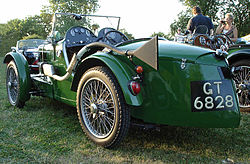| This article includes a list of references, related reading, or external links, but its sources remain unclear because it lacks inline citations. Please help improve this article by introducing more precise citations. (January 2018) (Learn how and when to remove this message) |
Motor vehicle
| MG C-type | |
|---|---|
 | |
| Overview | |
| Manufacturer | MG |
| Production | 1931–1932 |
| Body and chassis | |
| Class | sports car |
| Layout | FR layout |
| Powertrain | |
| Engine | 746 cc In-line 4 |
| Chronology | |
| Successor | MG Q-type Midget |

The MG C-type is a sports car that was produced by MG from 1931 to 1932. It was designed for competition use and based on the M-Type Midget. A special car, EX120 had been developed from the M-Type for George Eyston to make an attempt on the 750 cc class 24-hour record at Autodrome de Montlhéry in France. The attempt was successful and a series of replica cars were made which became the C-Type.
The car used a tuned short-stroke (73 mm) version of the bevel gear driven overhead camshaft engine from the 1928 Morris Minor and Wolseley 10 with a single SU carburettor and a new crankshaft producing 44 bhp (33 kW) at 6400 rpm. It could from 1932 be had with the crossflow head to be seen later on the MG J-type and a Powerplus supercharger version was also available with 52.4 bhp (39.1 kW) at 6500 rpm. Drive was to the rear wheels through a four-speed non-synchromesh gearbox. The chassis was new and took the form of a ladder frame with tubular cross members and passed under the rear axle. The suspension used half-elliptic springs and Hartford friction shock absorbers with rigid front and rear axles and centre lock wire wheels. The car had a wheelbase of 81 inches (2057 mm) and a track of 42 inches (1067 mm).
The body, which had no doors, was metal over an ash frame and had a pointed tail which held the spare wheel and cycle type front wings. Later cars had a more conventional rear with a slab-type fuel tank. The exhaust pipe was routed outside the car and finished with a spectacular fishtail. The record-breaking cars had a streamlined cowl over the radiator, but this was not usually fitted to later cars as it could cause overheating unless high speeds were maintained.
The standard car initially cost £295 or £345 for the supercharged version, rising to £490 and £575 by the end of production.
As well as the Montlhéry record, C-Types were used in many other competition events including a works team of fourteen cars entered in the 1931 Double Twelve event at Brooklands, where they took the first five places.
Further reading
- Green, Malcolm (1997). MG Sportscars. CLB International. ISBN 1-85833-606-6.
- Sedgwick, Michael (1989). A–Z of Cars of the 1930s. Bay View Books. ISBN 1-870979-38-9.